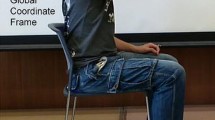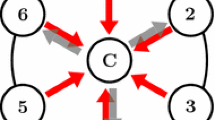Abstract.
A kinematic construction rule determining the trajectory of human sequential movements is formulated using minimum-jerk and minimum-angular-jerk trajectories. The kinematic construction rule states that the observed trajectory of sequential movements coincides with a weighted average of the minimum-jerk trajectory and the segmented minimum-angular-jerk trajectory. This rule covers not only point-to-point movements but also simple sequential movements. Five kinds of experiments that measure the trajectories in planar, multijoint sequential arm movements were conducted. The measured trajectories coincide with the predictions made on the basis of the kinematic construction rule presented here. Moreover, predictions of previous models such as the minimum-jerk, the equilibrium-trajectory, and the minimum-torque-change models are shown to be incompatible with our observations of sequential movements.
Similar content being viewed by others
Author information
Authors and Affiliations
Additional information
Received: 31 October 1997 /Accepted in revised form: 18 November 1998
Rights and permissions
About this article
Cite this article
Okadome, T., Honda, M. Kinematic construction of the trajectory of sequential arm movements. Biol Cybern 80, 157–169 (1999). https://doi.org/10.1007/s004220050514
Issue Date:
DOI: https://doi.org/10.1007/s004220050514




